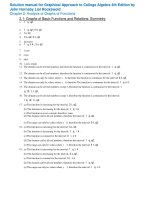Download test bank for a graphical approach to algebra and trigonometry 5th edition by john hornsby lial rockswold
Bạn đang xem bản rút gọn của tài liệu. Xem và tải ngay bản đầy đủ của tài liệu tại đây (5.87 MB, 143 trang )
Test Bank for A Graphical Approach to Algebra and Trigonometry 5th Edition by John
Hornsby Lial Rockswold
Link full download: />Link download solution: />MULTIPLE CHOICE. Choose the one alternative that best completes the statement or answers the question.
Determine the intervals of the domain over which the function is continuous.
1)
A) (-∞, ∞)
B)
C) [0, ∞)
1)
D)
Answer: A
2)
2)
A) [0, ∞)
Answer: B
3)
B) (-∞, ∞)
C) (0, ∞)
D) (-∞, 0]
3)
A) (-∞, ∞)
B) (-∞, 0); (0, ∞)
C) (-∞, 0)
D) (0, ∞)
Answer: A
4)
4)
_
A) (-∞, 2]
Answer: A
B) (-∞, 2); ( 2, ∞)
C) ( 2, ∞)
D) (-∞, ∞)
5)
5)
A) (-∞, ∞)
B) (-∞, 1); ( 1, ∞)
C) (-∞, -1); ( -1,
∞)
D) (0, ∞)
Answer: B
6)
6)
A) (-∞, ∞)
Answer: B
7)
B) (-∞, 2); ( 2, ∞)
C) (-∞,
4); ( 4, ∞)
D) (-∞, -2); ( -2,
∞)
7)
_
A) [ -1, ∞)
Answer: D
B) [ 1, ∞)
C) [0, 1)
D) [0, ∞)
8)
8)
A) (0, 5)
Answer: C
B) ( 5, ∞)
C) (-∞, ∞)
Determine the intervals on which the function is increasing, decreasing, and constant.
9)
A) Increasing on (-∞, 1]; Decreasing on [1, ∞)
B) Increasing on (-∞, -1]; Decreasing on [-1, ∞)
C) Increasing on [1, ∞); Decreasing on (-∞, 1]
D) Increasing on [-1, ∞); Decreasing on (-∞, -1]
Answer: D
10)
D) (0, ∞)
9)
10)
A) Increasing on (-∞, 0]; Decreasing on (-∞, 0]
B) Increasing on [0, ∞); Decreasing on (-∞, 0]
C) Increasing on (-∞, 0]; Decreasing on [0, ∞)
D) Increasing on (∞, 0]; Decreasing on [0, -∞)
Answer: B
11)
11)
A) Increasing on (∞, 0]; Decreasing on [0, -∞)
B) Increasing on [0, ∞); Decreasing on (-∞, 0]
C) Increasing on (-∞, 0]; Decreasing on (-∞, 0]
D) Increasing on (-∞, 0]; Decreasing on [0, ∞)
Answer: D
12)
12)
A) Increasing on (-∞, -3]; Decreasing on [ -3, ∞)
B) Increasing on [-3, ∞); Decreasing on [ -3, ∞)
C) Increasing on (-∞, -3]; Decreasing on (-∞, -3]
D) Increasing on [-3, ∞); Decreasing on (-∞, -3]
Answer: A
13)
13)
A) Increasing on (-∞, 0]; Decreasing on [0,
∞)
C) Decreasing on (-∞, ∞)
Answer: D
B) Increasing on [0, ∞); Decreasing on (-∞,
0]
D) Increasing on (-∞, ∞)
14)
14)
A) Increasing on [ 4, ∞); Decreasing on [ -4, ∞); Constant on [ -4, 4]
B) Increasing on [ 4, ∞); Decreasing on (-∞, -4]; Constant on [ -4, 4]
C) Increasing on (-∞, 4]; Decreasing on (-∞, -4]; Constant on [4, ∞)
D) Increasing on (-∞, 4]; Decreasing on [ -4, ∞); Constant on [4, ∞)
Answer: B
15)
15)
A) Increasing on [1, 3]; Decreasing on [-2, 0] and [3, 5]; Constant on [2, 5]
B) Increasing on [-2, 0] and [3, 5]; Decreasing on [1, 3]; Constant on
C) Increasing on [-1, 0] and [3, 5]; Decreasing on [0, 3]; Constant on [-5, -3]
D) Increasing on [-2, 0] and [3, 4]; Decreasing on [-5, -2] and [1, 3]
Answer: B
16)
16)
A) Increasing on [-3, -1]; Decreasing on [-5, -2] and [2, 4]; Constant on [-1, 2]
B) Increasing on [-3, 1]; Decreasing on [-5, -3] and [0, 5]; Constant on [1, 2]
C) Increasing on [-3, 0]; Decreasing on [-5, -3) and [2, 5]; Constant on [0, 2]
D) Increasing on [-5, -3] and [2, 5]; Decreasing on [-3, 0]; Constant on [0, 2]
Answer: C
Find the domain and the range for the function.
17)
17)
A) D: (-∞, ∞), R: (-∞, ∞)
B)
C)
D)
D:
D:
Answer: A
18)
, R: (-∞, 0]
, R: [0, ∞)
D: [0, ∞), R:
18)
A) D: (0, ∞), R: (0, ∞)
C) D: [0, ∞), R: [0, ∞)
Answer: D
B) D: (-∞, 0], R: (-∞, 0]
D) D: (-∞, ∞), R: (-∞, ∞)
19)
19)
A) D: ( 2, ∞), R: [0, ∞)
C) D: [ 2, ∞), R: [0, ∞)
Answer: C
B) D: [0, ∞), R: (-∞, 0]
D) D: (0, ∞), R: (-∞, 0)
20)
20)
A) D: (0, ∞), R: (-∞, 3]
C) D: (-∞, 0), R: (-∞, 0)
Answer: D
B) D: (-∞, ∞), R: (-∞, ∞)
D) D: (-∞, ∞), R: [6, ∞)
21)
21)
A) D: [0, ∞), R: (-∞, 8]
C) D: (-∞, 8], R: [8, ∞)
Answer: B
B) D: (-∞, 8], R: [0, ∞)
D) D: (-∞, ∞), R: [0, ∞)
22)
22)
A) D: (-∞, 3) ∪ (3, ∞), R: (-∞, 1) ∪ (1, ∞)
C) D: (-∞, ∞), R: (-∞, ∞)
Answer: A
B) D: (0, ∞), R: (1, ∞)
D) D: (-∞, -3) ∪ (-3, ∞), R: (-∞, ∞)
23)
23)
A) D: (-∞, 4) ∪ (4, ∞), R: (-∞, 2) ∪ (2, ∞)
C) D: (-∞, -2) ∪ (-2, ∞), R: (-∞, -4) ∪ (-4, ∞)
Answer: D
B) D: (-∞, ∞), R: (-∞, ∞)
D) D: (-∞, 2) ∪ (2, ∞), R: (-∞, 4) ∪ (4, ∞)
24)
24)
A) D: [0, ∞), R: [0, ∞)
C) D: [0, ∞), R: [4, ∞)
Answer: C
25)
B) D: [4, ∞), R: [0, ∞)
D) D: [ -4, ∞), R: (-∞, 0]
25)
A) D: ( 5, ∞), R: (-∞, 0]
C) D: (-∞, ∞), R: (-∞, ∞)
Answer: C
B) D: (4, ∞), R: [0, ∞)
D) D: (0, ∞), R: [0, ∞)
Determine if the function is increasing or decreasing over the interval indicated.
26) f(x) = 7x - 5; (-∞, ∞)
A) Increasing
B) Decreasing
Answer: A
27)
f(x) =
- x; (1, ∞)
A) Increasing
Answer: A
28)
29)
f(x) =
- 2x + 1; (1, ∞)
A) Increasing
Answer: A
f(x) =
; (3, ∞)
A) Increasing
Answer: A
26)
27)
B) Decreasing
28)
B) Decreasing
29)
B) Decreasing
30)
30)
f(x) =
; (-∞, 0)
A) Increasing
Answer: A
B) Decreasing
31) f(x) =
; (-∞, 4)
A) Increasing
Answer: B
32) f(x) = ∣ x - 8∣ ; (-∞, 8)
A) Increasing
Answer: B
31)
B) Decreasing
32)
B) Decreasing
33)
33)
f(x) =
+ 7; (0, ∞)
A) Increasing
B) Decreasing
Answer: B
34) f(x) = -
34)
; (-3, ∞)
A) Increasing
Answer: B
B) Decreasing
Determine if the graph is symmetric with respect to the x-axis, y-axis, or origin.
35)
A) y-axis
Answer: A
B) Origin
C) y-axis, origin
35)
D) x-axis, origin
36)
36)
A) x-axis, origin
Answer: C
B) x-axis
C) y-axis
37)
D) y-axis, origin
37)
A) x-axis, origin
C) x-axis, y-axis, origin
Answer: C
B) Origin
D) x-axis
38)
38)
A) y-axis
Answer: D
B) x-axis, origin
C) x-axis
D) Origin
39)
39)
A) Origin
Answer: A
B) x-axis
C) y-axis
D) No symmetry
Based on the ordered pairs seen in the pair of tables, make a conjecture as t o whether the function defined in Y 1 is
even, odd, or neither even nor odd.
40)
40)
A) Odd
Answer: A
41)
B) Neither even nor odd
C) Even
41)
A) Even
Answer: A
B) Neither even nor odd
C) Odd
42)
42)
A) Even
Answer: C
B) Odd
C) Neither even nor odd
43)
43)
A) Odd
Answer: B
44)
B) Even
C) Neither even nor odd
44)
A) Neither even nor odd
Answer: C
B) Odd
C) Even
45)
45)
A) Odd
Answer: C
B) Even
C) Neither even nor odd
46)
46)
A) Odd
Answer: C
47)
B) Even
C) Neither even nor odd
47)
A) Neither even nor odd
Answer: B
B) Odd
C) Even
48)
48)
A) Neither even nor odd
Answer: C
B) Odd
C) Even
49)
49)
A) Odd
Answer: C
B) Even
C) Neither even nor odd
Determine whether the function is even, odd, or neither.
50) f(x) =
-5
A) Even
B) Odd
50)
C) Neither
Answer: A
51) f(x) = (x + 3)(x
A) Even
Answer: C
52) f(x) = -6
+ 1)
52)
B) Odd
53) f(x) = -7
C) Neither
53)
+8
B) Odd
A) Even
Answer: B
f(x) =
+
A) Even
Answer: A
55) f(x) = -5
A) Even
Answer: C
C) Neither
+ 8x
A) Even
Answer: B
54)
51)
B) Odd
C) Neither
54)
+1
B) Odd
C) Neither
55)
+ 3x - 1
B) Odd
C) Neither
56) f(x) =
56)
A) Even
Answer: C
B) Odd
C) Neither
57)
57)
f(x) =
A) Even
Answer: B
B) Odd
C) Neither
Determine whether the graph of the given function is symmetric with respect to the y-axis, symmetric with respect to
the origin, or neither.
58) f(x) =
58)
+2
A) y-axis
Answer: A
59) f(x) =
B) Origin
B) Origin
60) f(x) = 2
A) y-axis
Answer: B
A) y-axis
Answer: A
59)
+3
A) y-axis
Answer: A
61) f(x) =
C) Neither
C) Neither
60)
B) Origin
C) Neither
61)
+3
B) Origin
C) Neither
62) f(x) = -3
A) y-axis
Answer: B
62)
+ 6x
B) Origin
63) f(x) = 6
+7
A) y-axis
Answer: B
64) f(x) =
+
A) y-axis
Answer: A
C) Neither
63)
B) Origin
C) Neither
64)
+5
B) Origin
65) f(x) = 6
+ 5x - 3
A) y-axis
Answer: C
C) Neither
65)
B) Origin
C) Neither
66)
66)
f(x) = x +
A) y-axis
Answer: C
B) Origin
C) Neither
Provide an appropriate response.
67)
67)
True or False: The function y =
A) True
Answer: B
is continuous at x = 6.
B) False
68)
Sketch the graph of f(x) = . At which of these points is the function increasing?
A) 5
B) 0
C) 3
D) -3
Answer: D
69)
True or False: A continuous function cannot be drawn without lifting the pencil from the
paper.
A) False
B) True
Answer: A
70)
What symmetry does the graph of y = f(x) exhibit?
A) y-axis
Answer: A
B) Origin
68)
69)
70)
C) x-axis
D) No symmetry
71)
What symmetry does the graph of y = f(x) exhibit?
A) Origin
Answer: A
72)
B) y-axis
71)
C) x-axis
D) No symmetry
Complete the table if f is an even function.
72)
A)
B)
C)
D)
Answer: A
SHORT ANSWER. Write the word or phrase that best completes each statement or answers the question.
73)
Complete the right half of the graph of y = f(x) for each of the following conditions:
(i)
f is odd.
(ii) f is even.
73)
Answer: (i) f is odd.
(ii) f is even.
MULTIPLE CHOICE. Choose the one alternative that best completes the statement or answers the question.
Write an equation that results in the indicated translation.
74)
The squaring function, shifted 2 units downward
A)
B) y =
-2
C) y =
+2
74)
D) y =
y=
Answer: B
75)
76)
The absolute value function, shifted 6 units to the
A) y =
B) y =
+ 6
Answer: A
left
C) y =
The absolute value function, shifted 6 units upward
B) y =
C) y =
+ 6
Answer: B
75)
D) y =
- 6
77) The square root function, shifted 8 units to the right 77)
B) y =
C) y =
- 8
+ 8
Answer: C
78)
79)
The square root function, shifted 7 units to the left
A) y =
B) y =
- 7
Answer: D
The square root function, shifted
5 units upward
76)
D) y =
-6
A) y =
A) y =
D) y =
78)
C) y =
+ 7
D) y =
79)
A) y =
Answer: D
80)
- 5
B) y =
C) y =
The square root function, shifted 5 units downward 80)
B) y =
C) y =
+ 5
- 5
Answer: B
Use translations of one of the basic functions to sketch a graph of y = f(x) by hand.
81)
y=
-2
A)
B)
C)
D)
Answer: A
82)
y=
D) y =
+ 5
A) y =
D) y =
81)
82)
A)
B)
C)
D)
Answer: A
83) y =
A)
-2
83)
B)
C)
D)
Answer: D
84) y =
A)
C)
84)
B)
Answer: C
85) y =
A)
C)
85)
+1
B)
Answer: D
86) y =
A)
C)
86)
-8
B)









